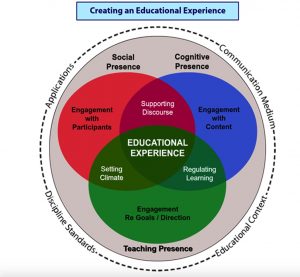30 Developing an Online Teaching Presence (also relevant to on campus course)
Teaching presence is defined as the design, facilitation, and direction of cognitive and social processes for the purpose of realizing personally meaningful and educationally worthwhile learning outcomes (Anderson, Rourke, Garrison, & Archer, 2001).
As a teacher, your role is to create and sustain presence when you teach online, just like you do in the on-campus course. It just looks and feels different. Online students need your presence and expertise from day one until the end of the semester.
There are three components of teaching presence in the Community of Inquiry.
Component 1: Design and Organization
Component 2: Facilitating Discourse
Component 3: Direct Instruction

